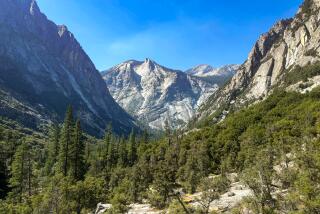Spelunkers Going to Great Depths to Save the Caves
- Share via
TUCSON, Ariz. — Cave enthusiasts in Arizona and New Mexico are volunteering about $200,000 of work annually, including repairing damage to caves and marking new trails.
Their efforts are designed to take care of Forest Service caves for future generations and to keep the agency from imposing a spelunking fee and opening the caves to novice tours.
“In places, we’re scraping half an inch to an inch of mud off beautiful formations that have been walked on for a hundred years,” said Dave Jagnow, conservation chairman of the National Speleological Society, whose members are doing the work.
Many caves have been closed for years because of destruction. “Our goal is to get these caves restored and trails laid out in them and get them once again opened to recreational caving,” Jagnow said.
The speleological society is the largest caving association in the United States with about 12,000 members.
Under an informal agreement started in 1998, the society’s local chapters are trying to donate at least $200,000 worth of work a year, half each in southeastern New Mexico’s Lincoln National Forest and in southeastern Arizona’s Coronado National Forest, Jagnow said.
In 1997, the Forest Service had proposed a three-year cave fee demonstration project in the two states, including tours of caves.
The fee proposal, intended to foster restoration, met with considerable resistance from spelunkers, said Jerry Trout, the Forest Service’s national coordinator for cave resources. But when the NSS offered the volunteer work, “we accepted that in lieu of the fees,” he said.
Of more than 100 caves in the Lincoln National Forest, most require vertical equipment, ropes and skills to negotiate drops of more than 200 feet, Jagnow said.
“The Forest Service was proposing to run tours of many of these caves, train novices in vertical techniques, provide all the equipment--ropes, hardhats and lights--and take them into vertical caves,” he said.
The agency’s liability, Jagnow said, would have been considerable. And taking novices on tours would have caused more damage, he added.
“It takes years of experience to move lightly through a cave and be aware of surroundings, without crashing your hardhat and light into a ceiling, without hearing the tinkle of ‘soda straws’ [thin, delicate floor-to-ceiling formations] you’ve just destroyed.”
As an alternative, Jagnow said “we tried to get as many cavers as possible to working on restoring the cave resources.”
Trout said the spelunkers keep up cavers’ registers, clean graffiti, remove trash, create trails with reflective tape or by setting out marking rocks, and repair broken formations where possible. They also conduct photo monitoring to study undue impacts or vandalism within a cave.
Some sites, such as New Mexico’s Hidden Cave, which abuts Carlsbad Caverns National Park, have been open for tours since the late 1800s.
Trout and Jagnow said education is reducing vandalism.
But Jagnow said he sees various cave formations for sale on an Internet auction site every week. Removal, destruction or vandalizing cave formations in New Mexico and Arizona, except on private property, is punishable by a $500 to $1,000 fine and up to six months in jail.
Trout said he expects the NSS’ three-year commitment to be extended.
“With their expertise and ethic, we rely on them heavily,” he said, adding that most people are “not interested in getting on ropes or squeezing through 8-inch holes.”
More to Read
Sign up for The Wild
We’ll help you find the best places to hike, bike and run, as well as the perfect silent spots for meditation and yoga.
You may occasionally receive promotional content from the Los Angeles Times.






